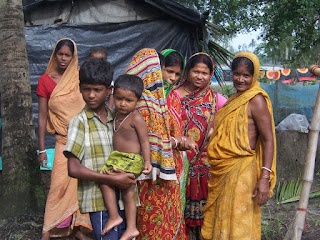We met with many times over several days with villagers in Pakhiralaya, one of the villages of the Sunderbans. We learned directly from them about the importance of domestic animals in their lives and local economy, and about the animal and human health challenges they face.
Here’s the bottom line on how the villagers themselves have informed our plan for Mere Saathi:
The villagers are all Hindu, but most of them are not vegetarian. (Still, no Hindu eats cow – ever.) Goats and chickens are used primarily for meat, cows for milk, and sheep for wool. The villagers said that they get most of their income from cow’s milk, secondly from goat’s meat. So we will be treating these animals for health issues to help them to produce more milk, more meat, and keep their animals around longer so that they bring them more income and sustenance.
There is a vet about 2 hours walk from the village where they can bring their animals if they need to, but they say it’s very expensive and that they do not get enough cash return from the animals to pay for these visits. When we told the villagers of our initial plan to provide basic care for domestic animals, every single one of them was incredibly supportive and said, enthusiastically, that they would use the service. They also offered to feed us, and to provide volunteers and to help us in any way that we needed. They said they’d be willing attend classes to learn about animal health management.
Here are the details from the villagers:
Domestic livestock is owned by families, not companies or cooperatives. Whole families own the animals, averaging 2-3 goats per family. Both men and women take turns tending the animals. The goats and cows and sheep are managed in a mixed way; they are allowed to roam and graze at times, and other times they are tethered and housed and fed grains, hay, and even fruit.
Before Cyclone Aila devastated the area in May 2009, the villagers said that almost every family had at least one cow that they used for milk. But cyclone killed 80 percent of their livestock, so that now only about one in ten families has even one cow. Since then it has been very hard to replace the animals due to lack of money, but also because soil salinization that resulted from the cyclone and the tidal surge and flooding it cause. Soil salinization has made vegetation more sparse, so that it’s hard to maintain large animals like cows.
We met one woman who still owned a cow. She reported that she got about 1.5 Liters from it in one milking. She milks her cow twice daily, gets the most of the milk out, then lets her calf suckle. She says that since Aila, with the poorer quality of vegetation, her cow gives less milk. She sells the milk for 20 rupees (about 50 cents) per liter in town. She rarely uses any of the milk herself. The villagers also dry the cow manure to use as fuel.
Since Aila, most of the families now have only the small, hardy Black Bengal goats. They’re a very small breed that’s used for meat. The vast majority of the meat from the goats is sold in an open air market in the village. They also sell live goats for about 300 rupees (about $8) per kg at about 1 yr of age. One of their biggest health concerns with the goats is Pox virus. Villagers are aware that a vaccine is available, which they do obtain when they have enough money.














